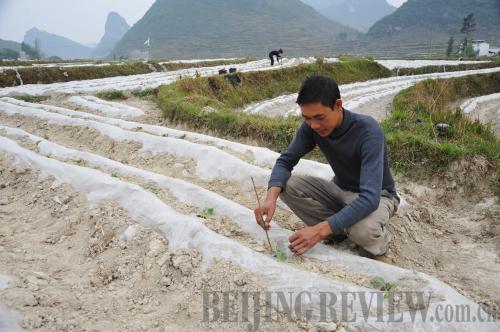|
 |
|
PROTECTING CROPS: A villager of Luli Village checks the condition of seedlings under plastic mulch in Dizhou Town, Guangxi Zhuang Autonomous Region on March 14 (ZHAO JINGWU) |
The Huangguoshu Waterfall, whose literal name in Chinese is the Yellow Fruit Waterfall, is located in Anshun in southwest China's Guizhou Province, and is the largest waterfall in the country and in all of Asia. Today, however, it has been so severely affected by a large-scale drought spreading through southwest China that it has ceased to flow since March 26.
In Guangxi Zhuang Autonomous Region, Guilin, a city known for having "the most beautiful mountains and rivers in the world," is also suffering from water shortages, and its beautiful scenery has been severely affected.
"Science and technology will answer the prayers of those living through the harshest drought in decades," said Zheng Guoguang, Director of the China Meteorological Administration, at a March 30 press conference that marked the launch of a national statute on meteorological disaster relief.
Artificial precipitation
When the meteorological department of Guizhou issued the forecast that there would be cloudy weather from the evening of March 29 to March 30 throughout the whole province, the staff of an aviation division of the Air Force under the Chengdu Military Area Command of the Chinese People's Liberation Army, who had been preparing to take off upon receiving the order, appeared very excited, "People will receive relief from water shortages due to our operations."
Because of previous weather conditions, it had not been possible to induce artificial precipitation for a long period of time. According to Zheng, the precipitation can only be induced in cloudy weather conditions at temperatures below zero degrees Celsius. "The clouds should be super-cooled clouds that contain unfrozen liquid water drops. The heavier the clouds are, the greater the likelihood of rainfall," he said.
He explained that if a sufficient number of ice cores form in the super-cooled clouds to absorb liquid water drops, precipitation can be successfully induced.
"When there are suitable atmospheric conditions, weather bureaus will adopt measures to induce greater rainfall," said Zheng.
According to him, two out of every three counties in China, or 1,959 counties throughout the country in total, have adopted artificial measures to induce precipitation or prevent hailstorms.
Nationwide, weather modification projects have covered more than 3.6 million square km, or nearly one third of China's total territory, requiring some 6,533 cannons and 5,939 rocket launchers.
"Currently, China's artificial precipitation equipment and the scale of its operations are amongst the most advanced in the world," Zheng said. These scientific operations, including artificial precipitation, have been included as part of the national administrative management system.
In 2002, the State Council, China's cabinet, issued the Administrative Regulations on Weather Modification, stipulating that weather modification operations must be organized and guided by the meteorological authorities under the leadership and coordination of governments at the county-level and higher. At present, China has established a sound system of artificial weather management, encompassing government departments at the national, provincial, municipal and county levels.
In 2008, in order to ensure the success of the opening and closing ceremonies of the Beijing Olympic Games, the city carried out the largest artificial precipitation operation in the country's history. On the opening day alone, the department launched 1,104 rockets to ensure fine weather in the area around the Bird's Nest, or the National Stadium. According to reports, similar plans for ensuring salubrious weather will be adopted during the Shanghai World Expo and the Guangzhou Asian Games later this year.
However, weather modification is also considered a controversial technology internationally.
"It is an international problem," said Guo Xueliang, Director of the Center of Weather Modification of the China Meteorological Administration.
Scientists around the world, including China, have been searching for scientific proof of the effects of weather modification for many years. Israeli scientists have even performed statistical experiments for 15 years, concluding that the success rate for artificial precipitation is between 13 and 15 percent. However, China performed many experiments around the Gutian Reservoir in southeast China's Fujian Province between 1975 and 1986, and achieved an artificial precipitation rate of up to 24 percent.
"We are not trying to defeat nature. This is impossible and against natural law. We are just trying to use the weather to create suitable living conditions for people," said Li Bing, Deputy Director of the Henan Provincial Office of Weather Modification.
He said that the most important catalysts for China's weather modification measures are dry ice, silver iodide and ammonia. Dry ice and ammonia transform into carbon dioxide following vaporization and become part of the atmosphere. In general, silver iodide is seldom used, and even if it is used, the dosage is always 100-300 gram per airplane, which creates no pollution when released at high altitudes over an area of 10,000 square km.
Safeguarding harvests
 |
|
CREATING RAINS: A plane of the Air Force under the Chengdu Military Area Command of the Chinese People's Liberation Army takes off from the Huangguoshu Airport in southwest China's Guizhou Province to induce artificial precipitation on March 29 (LIU YINGHUA) | In drought-hit Fusui County in Guangxi, the soil of many farms has turned into sallow lumps due to lack of water. But on Fan Junfeng's farm in the village of Qutao, the cantaloupe seedlings are both vigorous and green.
"Plastic mulching and drip irrigation techniques have helped us," said Fan.
In Guangxi, technicians guide farmers in placing sheets of plastic film over field ridges in order to retain soil moisture. "With this technology, farm land only requires approximately a single round of irrigation each week," said Bin Shiyou, Director of the Regional Soil and Manure Station.
"We primarily adopt three kinds of anti-drought techniques, one of which is plastic mulching which employs the 'three-avoidances techniques,'" said Bin. The "three-avoidances techniques" have become widely popularized throughout Guangxi, and refer to the avoidance of rain, the avoidance of cold and the avoidance of sun damage, by methods including plastic mulching, plastic-covered tunnels, net sheds and fruit bagging.
The second technique is drip irrigation with fertilized water. The technique involves using pumps to obtain water from water sources, and then filtering the water and adding fertilizers and chemicals. The water is then delivered to the soil through pipelines drilled with numerous small holes. Due to the effects of gravity the water, as well as the fertilizers and chemicals that it contains, will drip into the soil around the roots of crops and provide them with sufficient sustenance.
"This technique can save a considerable amount of water. The water used by this technique is only one seventh that required by surface irrigation and one third that of sprinkling irrigation," Bin said.
"The third technique is deep scarification," he said. "The combination of these three techniques can save 60-percent more water."
At the same time, a polymer resin called Super Absorbent Polymer (SAP) has also been welcomed by a large number of farmers. The SAP has remarkable absorbing capacity, and is capable of absorbing water equal to 100-200 times its own weight.
"Placing a small piece of this polymer resin at the root of a crop is like building a miniature reservoir for the plant," said He Lixin, Deputy Director of the Regional Soil and Manure Station of Guangxi.
He said that water would evaporate quickly after irrigation due to the current severe drought conditions, but by using SAP, water could be preserved in the soil.
In Guangxi's Qinzhou City, agricultural technicians are promoting the ratoon method of cultivating rice. Under their guidance, farmers can successfully postpone the sowing of the first crop of rice to avoid the early spring drought. After reaping the first crop of rice, the ratoon rice will be retained for cultivation in late September to avoid the autumn drought, and guarantee the harvest of the whole year.
"We also have what is referred to as a No.1 technique," said Chen Jiang, Director of the Production Section of the Qinzhou Municipal Bureau of Agriculture. One of the most important techniques is "upland rice seeding cultivation." With this technique, farmers do not need to transplant rice seedlings, but directly scatter rice seeds into furrows before placing soil and fertilizer on top of them. This upland rice is far more drought-resistant than corn or soybean.
At present, the Qinzhou Municipal Bureau of Agriculture has arranged for more than 12,000 staff to provide guidance to farmers.
In China, research on drought-resistant rice has been undertaken for many years. In the mid-1980s, China Agricultural University created a new form of drought-resistant rice, and in the subsequent 20 years, many research achievements have been made in gene-improvement and germplasm enhancement methods for drought-resistant rice. Today, this research has become a new hotspot and a strategic high-ground for the scientific study of rice both at home and abroad.
In addition to this, China Agricultural University has also participated in the Research on Asian Drought Tolerant Rice and many other research projects, which have been included on the list of key research programs of the Consultative Group on International Agricultural Research and the European Union. Meanwhile, the university is also cooperating with the International Rice Research Institute to accelerate the application of research accomplishments in real life, to promote the development of drought-tolerant rice around the world.
| 